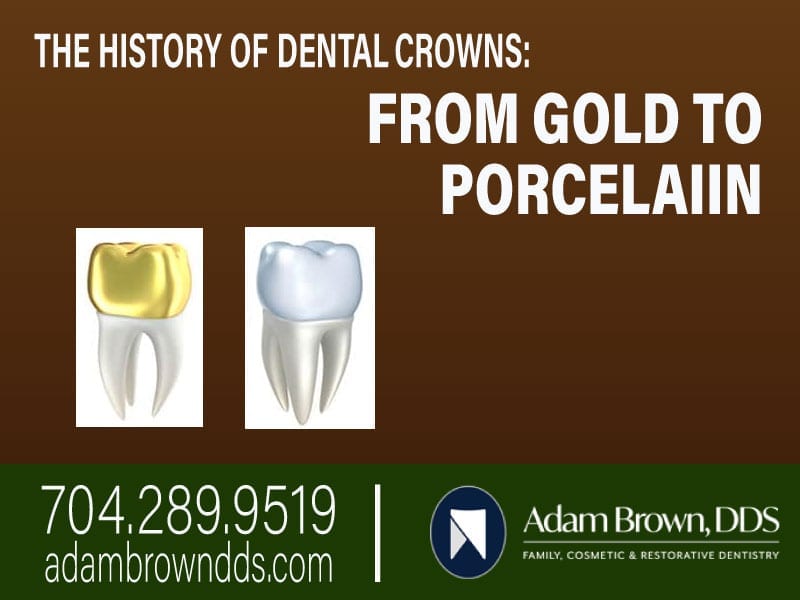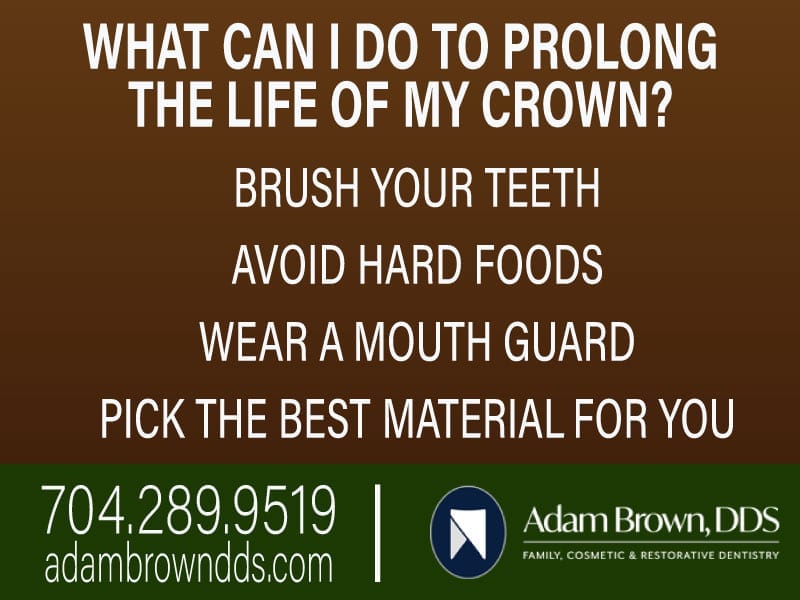The History Of Dental Crowns: From Gold To Porcelain

At Carolina’s Dental Choice, our goal is to make sure that you have a happy, healthy, and beautiful smile. To do that, many patients need a crown to cover one of their teeth but they aren’t exactly sure what the purpose of the crown is or what the procedure entails. Don’t worry; we can answer any questions you have about dental crowns and provide you with a little more information on the history of crowns.

First things first: What is a crown? A crown is essentially a cap that covers a tooth. Crowns are placed over a tooth to improve its shape, size, strength, and even help its appearance. A dental crown can be needed for many reasons, such as:
- Protecting a Tooth – If a tooth is cracked or even decaying, a crown can protect a weak tooth from further damage.
- Restoring a Tooth – A broken tooth needs a crown to restore the functionality of the tooth.
- Covering a Filling – Sometimes, if a tooth has a large filling and there is not a lot of tooth left, a crown will be used to cover and support the tooth and filling.
- Holding a Dental Bridge in Place – A dental bridge is something that dentists use to bridge a gap between teeth when a tooth is missing. A crown may be used to cover this gap.
Dental crowns actually have a very interesting history that dates back thousands of years. Four thousand years ago, Luzon, an island in the Philippines, gold was used to modify teeth. Skeletons have been found with gold caps and gold tooth replacements. Evidence suggests that this practice was popular with the chiefs of the time and was a symbol of wealth and power in society. An ancient Italian civilization, the Etruscans, have also been discovered as using gold for dental crowns as far back as 700 B.C. It is thought that wealth and luxury were important to these people and they put gold dental crowns to cover their teeth. Some skeletons were also found with what are essentially the first dental bridges: artificial teeth were held in place with a gold wire which then banded the fake teeth to real teeth. Pretty cool!
Europeans didn’t start utilizing modern dental practices until around the 1400s. They started by carving dentures from bone or ivory and around the 1700s, human teeth were actually the most popular tooth replacement. But this practice did not work well so it quickly fell out of practice. Porcelain dentures became the most successful way to replace teeth and by the 1800’s, porcelain was the standard material for crowns. The first modern dental crown was created by Dr. Charles Land in 1903. He created an all-porcelain jacket by taking a broken tooth and reconstructing it with a porcelain cover. This essentially made the tooth look brand new. This dental crown practice was used until the 1950s, which is when dental technologies started developing into what we now use as dental crowns.
Today, dental crowns can be made with four different types of materials:
- Ceramics – These crowns are made with materials that are porcelain based. The benefit to these fillings are the natural look they give teeth, as the color blends well with natural teeth. Porcelain crowns are best for restoring the front teeth because of this. These crown resist wear-and-tear but can become brittle in cases with heavy biting.
- Porcelain Fused to Metal – These crowns are attached to the tooth with a metal base and porcelain is then fused to the metal. These crowns make the restoration stronger than if a crown is made of only porcelain. These crowns also better prevent dental decay from recurring. Porcelain fused metal crowns are very durable.
- Gold Alloys – While there are commonly called gold crowns, these crowns are made up of gold, copper, and other metals. This creates a strong material that supports the tooth. This is a strong material that doesn’t wear or fracture easily. This material also works well with natural gum tissue.
- Base Metal Alloys – These crowns are made with metals that are strong and resist corrosion. When preparing for crowns made with this material, the dentist is able to remove the least amount of healthy tooth. Additionally, this material is gentle on other teeth that touch the crown.
A question that comes up a lot when discussing crowns is “How long will my crown last?” Depending on the material used to make the crown and the dental care of a person, a crown can have a varying lifespan. On average, dental crowns can last from ten to thirty years. However, there are factors such as dental hygiene practices that affect how long a crown can last. Some crowns may crack after some time due to trauma and sometimes the problem is with the tooth itself. Also, some crowns are simply not fitted properly.

Some tips to prolonging the life of a crown:
- Brush Your Teeth – It’s always the first thing on the list but brushing your teeth is the most important way to take care of your teeth and your crowns.
- Avoid Hard Foods – If you regularly bite into hard foods or ice, your crown is at risk of cracking.
- Wear a Mouth Guard – If you are prone to grinding your teeth in your sleep or participate in sports, wearing a mouth guard protects your teeth and your crowns.
- Pick the Best Material for You – There are many choices for which material to use for a dental crown, make sure you talk with your dentist and pick the best material for your teeth.
Carolina’s Dental Choice wants to help you understand how dental crowns work. There are a lot of questions to ask if you need a crown: What is it? How long will it take? How much will it cost? We at Carolina’s Dental Choice are happy to answer any questions you may have. If you have questions about replacing current dental crowns or are just ready for a dental checkup, give us a call at 704-289-9519.
